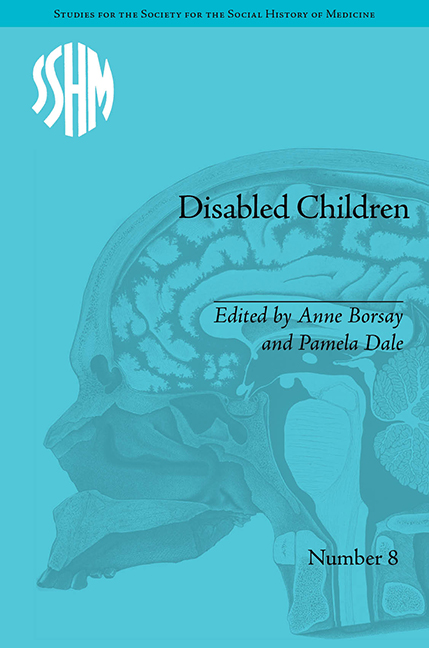Book contents
- Frontmatter
- Contents
- Acknowledgements
- Notes on Contributors
- Introduction: Disabled Children – Contested Caring
- 1 Club Feet and Charity: Children at the House of Charity, Soho, 1848–1914
- 2 Insanity, Family and Community in Late-Victorian Britain
- 3 The Mixed Economy of Welfare and the Care of Sick and Disabled Children in the South Wales Coalfield, c. 1850–1950
- 4 The Question of Oralism and the Experiences of Deaf Children, 1880–1914
- 5 Exploring Patient Experience in an Australian Institution for Children with Learning Disabilities, 1887–1933
- 6 From Representation to Experience: Disability in the British Advice Literature for Parents, 1890–1980
- 7 Treating Children with Non-Pulmonary Tuberculosis in Sweden: Apelviken, c. 1900–30
- 8 Health Visiting and Disability Issues in England before 1948
- 9 Spanish Health Services and Polio Epidemics in the Twentieth Century: The ‘Discovery’ of a New Group of Disabled People, 1920–70
- 10 Cured by Kindness? Child Guidance Services during the Second World War
- 11 Education, Training and Social Competence: Special Education in Glasgow since 1945
- 12 Hyperactivity and American History, 1957–Present: Challenges to and Opportunities for Understanding
- Notes
- Index
2 - Insanity, Family and Community in Late-Victorian Britain
- Frontmatter
- Contents
- Acknowledgements
- Notes on Contributors
- Introduction: Disabled Children – Contested Caring
- 1 Club Feet and Charity: Children at the House of Charity, Soho, 1848–1914
- 2 Insanity, Family and Community in Late-Victorian Britain
- 3 The Mixed Economy of Welfare and the Care of Sick and Disabled Children in the South Wales Coalfield, c. 1850–1950
- 4 The Question of Oralism and the Experiences of Deaf Children, 1880–1914
- 5 Exploring Patient Experience in an Australian Institution for Children with Learning Disabilities, 1887–1933
- 6 From Representation to Experience: Disability in the British Advice Literature for Parents, 1890–1980
- 7 Treating Children with Non-Pulmonary Tuberculosis in Sweden: Apelviken, c. 1900–30
- 8 Health Visiting and Disability Issues in England before 1948
- 9 Spanish Health Services and Polio Epidemics in the Twentieth Century: The ‘Discovery’ of a New Group of Disabled People, 1920–70
- 10 Cured by Kindness? Child Guidance Services during the Second World War
- 11 Education, Training and Social Competence: Special Education in Glasgow since 1945
- 12 Hyperactivity and American History, 1957–Present: Challenges to and Opportunities for Understanding
- Notes
- Index
Summary
Introduction
In the era known to modern scholars of British history as ‘the age of improvement’, Victorians sought to better identify, categorize and manage those individuals who were unable to conform to society's expectations. At this time disabled children living with physical and sensory impairments, and/or what we would now understand to be learning difficulties and/or mental health problems, came under increasing scrutiny. Although histories of childhood and disability issues have tended to neglect mental health, insane children arguably represented a particular problem for Victorian society. This was because contemporary actors believed their disabilities compromised their ability to function within their own families and within the larger community. With children seen as the nation's future, questions relating to the care and control of young people stood precariously between the family and the state. An insane child was not only likely to cause family anguish but also to create concern, even fear, within the local community. One writer described such children as ‘a plague on the neighbourhood’. Such thinking tended to encourage official intrusion into the private, domestic world of the family to protect the public and/or defend insane people from neglect or abuse.
While many aspects of the care of disabled Victorian children are unrecorded and elude historians, the committal of insane children to lunatic asylums created voluminous paperwork. Surviving records provide a rare opportunity to look more closely at the experiences of these young people before, during and after official confinement.
- Type
- Chapter
- Information
- Disabled ChildrenContested Caring, 1850–1979, pp. 29 - 42Publisher: Pickering & ChattoFirst published in: 2014



